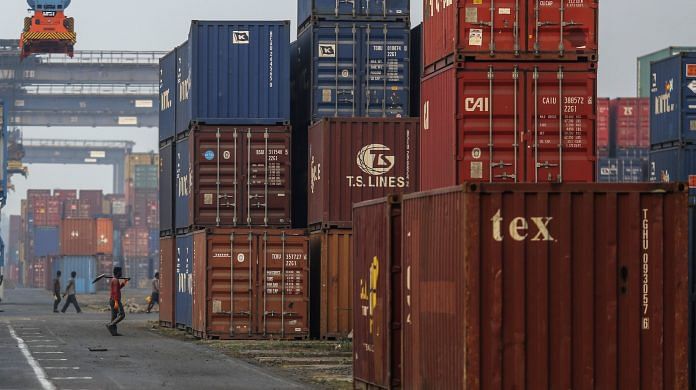New Delhi: Over the last seven months, Indian merchandise exports have cumulatively hit an all-time high of $235 billion and it is likely that the Indian government will breach its ambitious goal of $400 billion in this fiscal.
Over the last decade or so, Indian exports have hovered around $250-300 billion, and the highest-ever was in the financial year 2018-19 when the country’s total merchandise shipments reached $330 billion.
Analysts say this is a product of a sharp recovery from “low baseline” exports during the pandemic last year, overall economic recovery especially in the world’s two major economies — the US and China — and heightened commodity prices world round.
‘Low baseline effect’
According to Zico Dasgupta, a macroeconomics expert and Assistant Professor at Azim Premji University, the seemingly high increase in exports is due to “low baseline effect”.
He explained that there was a shrinkage in exports in 2020, which led to a “low baseline” and that the recent rise in exports — particularly from March 2021 onward — is a sharp recovery of that. “For example, you can see that the merchandise exports which India had in March 2021 was more or less seen as what we had in March 2019,” he added.
Exports reached $35.2 billion in March 2021 compared to $32.7 billion in March 2019, according to commerce ministry data.
“Also, the broad global recovery is being reflected. There are only three countries which constitute about 30 per cent of India’s export share — the US, UAE and China. So, the recoveries particularly of the US and China, would have an impact on our rise in exports,” said Dasgupta.
According to government data, India’s top export destinations for the April-September period this year have been the US at $36 billion, UAE at $12.9 billion, China at $12 billion, Bangladesh at $6.5 billion and Singapore at $6 billion.
Also read: Economic recovery has finally begun, but India needs to watch out for global headwinds
Impact of heightened commodity prices
Some analysts have argued that the rise in exports is due to heightened commodity prices in petroleum products, refined crude oil, and gems and jewellery.
“Because of the loose monetary policies everywhere in the world, commodities as an asset class are on a high. So, there’s a clear increase in the commodity segment,” Dhiraj Naiyyar, Chief Economist at Vedanta Resources & Chairman of Assocham’s National Council on Trade, told ThePrint.
He also added that engineering goods like metal products, industrial machinery, equipment and auto components, have also increased in value partly because of the quick economic recovery in the world’s two biggest economies – the US and China.
Exporters see surge in demand, but logistical challenges remain
ThePrint also spoke to exporters who have seen a surge in business in recent months but still face logistical challenges like container shortages.
Patton International, a Kolkata-based export house that supplies engineering goods mainly to North America, has seen a 60-70 per cent surge in demand since March this year.
Speaking to ThePrint, Sumit Goyal, head of operations at the company said: “We have seen quite a big surge in demand from all our buyers, and they’re shifting quite a lot of business from China to India. We have expanded our capacity and that also got sold out. Existing customers’ demand has gone up by almost 60-70 per cent”.
That said, exporters like Patton International continue to face container shortages which is part of a global problem. Container shortages have come about because there are fewer shipping vessels operating due to Covid-19, and as a result, fewer are being picked up and many are left stuck at ports for long periods of time.
A few weeks ago, Patton International, was moving more than half its containers from Kolkata to Mumbai for exports to the US because there weren’t enough containers on the east coast.
India diversifying exports into electronics, pharma
India’s top commodity groups for exports include petroleum products, gems and jewellery, cereals, cotton and textiles but it appears there is new focus on “sunrise” sectors like electronics and pharma. Sunrise sectors refer to those developing sectors or markets that are expected to see a rapid boom.
According to Ajay Sahai, Director General and CEO of Federation of Indian Export Organisations (FIEO), a trade promotion body under the Ministry of Commerce: “We have fairly diversified our exports and even electronics are doing very well. From the way the PLI [Production Linked Incentive] scheme has been rolled out, we are seeing success in mobile exports and other segments of electronics.”
He added that he expects mobile exports to hit $8-10 billion by the next fiscal.
Also read: Phone, fridge, pasta delivered — a global shortage of shipping containers is worrying world






